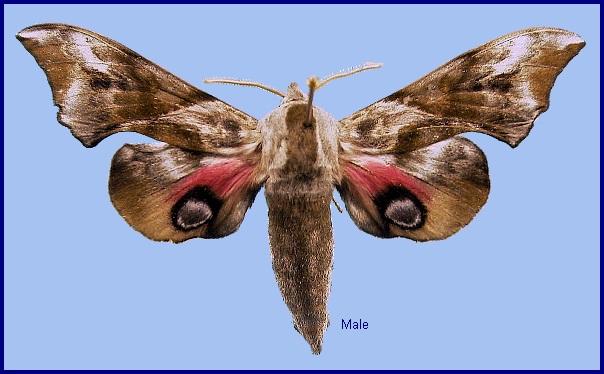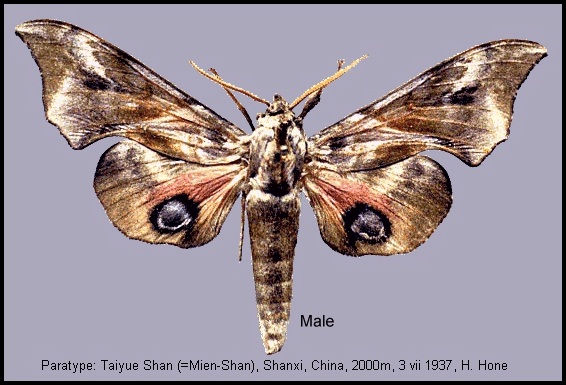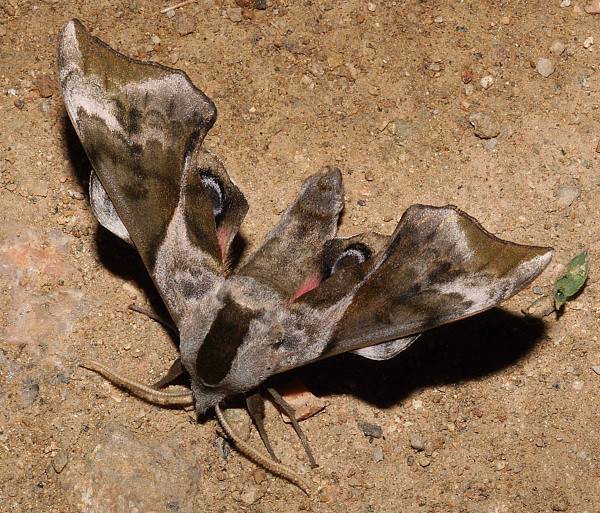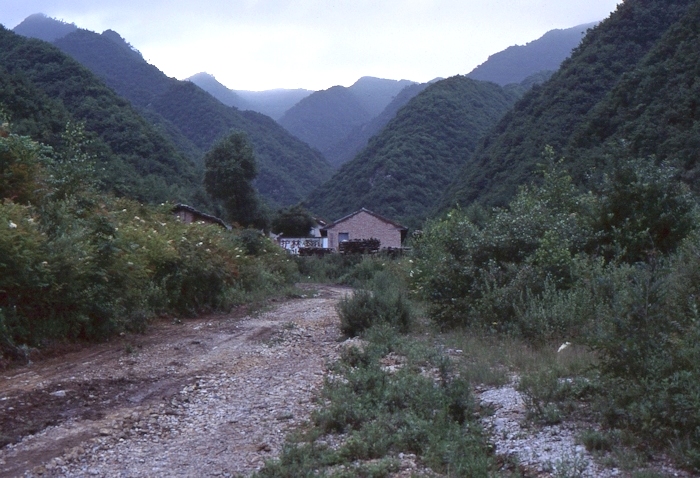


Smerinthus minor Mell, 1937, Dt. ent. Z. 1937: 5. Type locality: China, south Shensi [Shaanxi, Qinling], Taipeishan [Taibai Shan], <<33.8°N 108°E>>, 1700m.
Like a small, grey Smerinthus ocellata ocellata (Linnaeus, 1758). Distinguishable from other Chinese species of Smerinthus by the angular protrusion on the lower half of the forewing outer margin at vein M3.
Similar to Smerinthus kindermannii Lederer, 1853, but uncus apex sharper, gnathos sharper and half the length of uncus. Valva more rounded. Sacculus leaf-shaped, basal part narrower and harpe longer than S. kindermannii. Phallus shorter and wider than S. kindermannii, apical process longer, sharper and more curved, lateral sclerite absent (Jiang, Li, Yan, Wang, Zheng & Hu, 2024).


A montane species confined to cool temperate deciduous forest zones.

Univoltine; mainly early June to early July. However, one individual was recorded from Longnan, Gansu, on 9.v.2022 (ZhengBang Xu, pers. comm. 2022).
OVUM: Oval, pale green, becoming greyish white before hatching. Laid singly or in pairs beneath leaves (Jiang, Li, Yan, Wang, Zheng & Hu, 2024).
LARVA: In the first instar head green, smooth; body cylindrical, dorsal surface green, ventral surface with last abdominal and anal segments deep green and semi-translucent; prolegs yellow-green, true legs green. Similar in the second instar, but larger, body green with yellow-green oblique lateral stripes, head green with yellow-green dorso-lateral stripe. Prolegs with a yellow patch. The third instar is similar to second instar, but larger, body yellow-green with yellow lateral line, head yellow-green with yellow dorsal stripe and dorso-lateral stripe, separating the face from the cheek. Prolegs with a yellow-orange patch. The fourth instar is similar to third instar, body deep green with faded yellow lateral oblique stripes except on segments 9-12 to horn. Spiracles black. Horn yellow-orange with tiny spinules. Prolegs with a purple-pink patch (Jiang, Li, Yan, Wang, Zheng & Hu, 2024).
The final and fifth instar is similar to fourth instar, but much larger, body emerald green with lateral yellow-white oblique stripes very faded; only on segments 11-12 to horn is an oblique yellow-white line retained. True legs deep brown, prolegs emerald green with a brown-purple patch. Horn emerald green with minute surface spines. Spiracles black, with a yellow tiny patch inside. The larva becomes darker prior to pupation (Jiang, Li, Yan, Wang, Zheng & Hu, 2024).
PUPA: Typical Smerinthus. Tongue, thorax, and wing cases blackish-brown. Abdomen dark ochre above. Legs brownish-black. Length of antenna shorter than legs. Cremaster short and sharp (Jiang, Li, Yan, Wang, Zheng & Hu, 2024).

Photos: Early stages of Smerinthus minor from Huairou, Beijing, China. A. Egg; B. First instar larva; C. Third instar larva; D. Fourth instar larva; E. Fifth instar larva; F. Pupa (© Jiang, Li, Yan, Wang, Zheng & Hu, 2024).
Larval hostplants. Unknown in the wild, but accepted Spiraea trilobata L. in captivity (Jiang, Li, Yan, Wang, Zheng & Hu, 2024).
Unknown.
China: Hebei/Beijing (Miaofeng Shan; Baihua Shan; Laowei Farm House, near Hua'ertai (39°46'56.5"N 115°31'31.7"E); Huairou District; Mentougou; Sandaoling; Chiwawu; Xisi); Shanxi (Taiyue Shan, 2000m); Shaanxi (Qinling, Taibai Shan, 1700-2000m; Haopingsi, Taibai Shan; Baoji, Taibai Shan); Gansu (Longnan); Zhejiang; Hubei (Tapien Shan, 900-1800m); Sichuan (Jiuzhai Gou (Helmut Haas, iNaturalist 2024)); Hunan (Wuling Shan).
Once considered endemic to the Taibai Shan in the western Qinling Mountains of Shaanxi, where it is not uncommon at 2000m (11 specimens in the SFSI and more than 10 in the NAUY). However, Yang (1978) recorded and illustrated a male from the Miaofeng Mountains near Beijing, but misidentified it as Smerinthus tokyonis Matsumura. There is also a specimen in the IZAS from the Wuling Mountains, Hunan.
Endemic to China.

Map: Distribution of the genus Smerinthus in eastern Asia. The blue dotted line indicates the range of S. caecus, the red dotted line indicates the range of S. kindermannii, the orange spots indicate the range of S. minor, the green dotted line indicates the range of S. o. ocellata, the purple patch indicates the range of S. planus, the black spots indicate the range of S. szechuanus and the yellow spots indicates the range of S. tokyonis (© Jiang, Li, Yan, Wang, Zheng & Hu, 2024).
Holarctic; eastern Palaearctic region. Pleistocene refuge: Monocentric -- Sinoeremic refugium.
 Return to Sphingidae of the Eastern Palaearctic species list
Return to Sphingidae of the Eastern Palaearctic species list